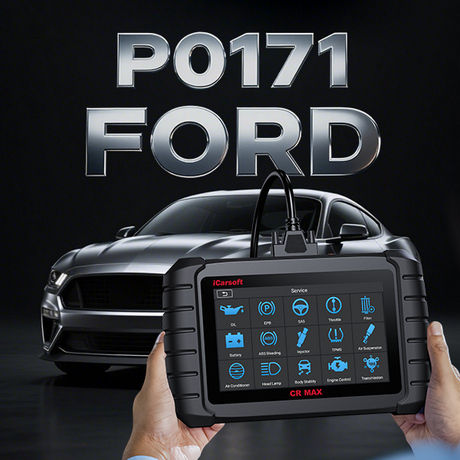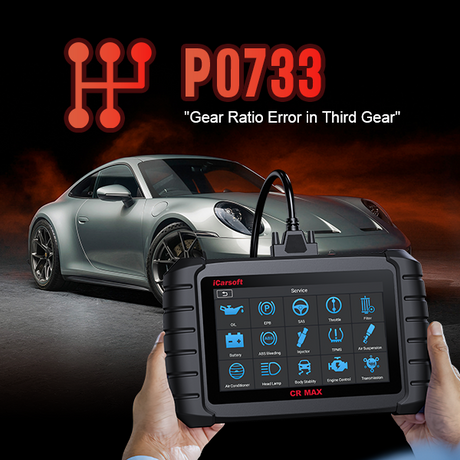Last month, I was driving my 2015 Ford F150 through a rainy stretchwhen my check engine light popped on. After scanning it with my iCarsoft CR Eagle, I found a P0451 code—a pesky EVAP system issue. Having dealt with codes like P0299 before, I knew I could tackle this myself. In this guide, I’ll share how I fixed the P0451 code on my Ford F150, using tools like the iCarsoft CR MAX, and give you tips to handle it on your own Ford. If you’re curious about related EVAP codes, check out iCarsoft’s guides on P0451 and P0452 for more insights. Let’s dive in!

1. The Day My Check Engine Light Came On
It was a damp morning, and I was on my way to pick up some supplies in my 2015 Ford F150 with the 2.7L EcoBoost engine. After a heavy rain, my dashboard lit up with the check engine light. I pulled over, grabbed my iCarsoft CR Eagle, and scanned it—up popped the P0451 code. I’d seen similar EVAP issues on forums, but this was my first time dealing with it on my truck. A quick search told me it was an EVAP pressure sensor issue, and I knew I had to act fast to keep my truck running smoothly.
2. What Does the P0451 Code Mean?
The P0451 code on a Ford means there’s a problem with the Evaporative Emission Control System (EVAP) pressure sensor’s range or performance. In simpler terms, the sensor that monitors pressure in your fuel tank’s vapor system isn’t reading correctly. On my F150, this sensor is on top of the fuel tank, and it’s crucial for catching fuel vapors and preventing them from escaping into the air. When the sensor’s voltage is off—say, outside the normal 0 inches of water at atmospheric pressure—it triggers this fault. It’s not Ford-specific; this code applies to any vehicle with an EVAP system. For a deeper dive into this code, iCarsoft’s P0451 guide has some great background info.
3. Why Did This EVAP Issue Show Up?
After digging into the issue and talking to a mechanic friend, I found a few common reasons for this EVAP fault on a Ford:
- Faulty Fuel Tank Pressure Sensor: On my F150, the sensor was the culprit—it wasn’t reading pressure correctly after getting wet from the rain.
- Wiring Issues: Corroded or damaged wires in the EVAP system can cause bad readings. I’ve seen this on older Fords with high mileage.
- Capless Filler Neck Problems: Many F150 owners report issues with the capless fuel system not sealing properly, especially after debris gets in.
- Purge Valve Issues: A stuck or leaking purge valve can mess with pressure readings—I’d dealt with a similar issue on a P0299 code before.
- Powertrain Control Module (PCM) Fault: Rarely, the PCM itself might be glitchy, but this is less common.

Interestingly, I noticed on forums that this issue often pops up after heavy rain or humid weather, which matched my experience that morning. If you’re seeing related codes like P0452, check out iCarsoft’s P0452 guide for more on EVAP pressure sensor issues.
4. Signs of a P0451 Code on a Ford
Here’s what I noticed when the P0451 code showed up on my Ford F150, and what you might see too:
- Check Engine Light: The most obvious sign—my dashboard lit up and wouldn’t go away.
- Fuel Smell: I caught a faint gas odor near the fuel tank after parking.
- Fuel Economy Drop: My truck’s usual 17 MPG dropped to about 15 MPG that week.
- Refueling Issues: Filling up was tricky—the pump kept stopping like the tank was full, even though it wasn’t.
5. Is the P0451 Code Common in Ford F150s?
From what I’ve seen on forums like f150forum.com, the P0451 code on a Ford F150 isn’t rare, especially in models from 2004 to 2018. My 2015 F150 with 45,000 miles fits right into that range. Other Fords, like the Escape and Focus, can also throw this code, often due to the capless fuel system or sensor issues. A thread I found mentioned a 2018 F150 with just 21,000 miles having the same problem, often after rain—just like mine!
6. How Serious Is This EVAP Fault?
The P0451 code isn’t a “stop driving now” issue, but it’s not something to ignore either. For me, it meant my F150’s emissions system wasn’t working properly, which could lead to failed emissions tests down the road. Plus, the drop in fuel economy was costing me extra at the pump. If left unchecked, it might also trigger other EVAP codes like P0452, which deals with similar pressure sensor issues—iCarsoft’s P0452 guide explains this in more detail.
7. Can I Still Drive with This Issue?
I drove my F150 for a few days with the P0451 code while I figured out a fix, and it was fine for short trips. But I wouldn’t recommend going too long without addressing it. The EVAP system helps control emissions, and a fault can lead to worse fuel efficiency or even damage other components over time. Plus, if you’re in a state with strict emissions testing, you’ll likely fail until it’s fixed.
8. How I Diagnosed the P0451 Code with iCarsoft
I’ve been using iCarsoft tools for years, and they didn’t let me down here. Here’s how I diagnosed the P0451 code on my Ford F150 with my CR Eagle and CR MAX:
- Connect the Scanner: I plugged my CR Eagle into the OBD2 port under the dashboard.
- Scan for Codes: It pulled up the P0451 code right away, confirming an EVAP issue.
- Check Live Data: Using the CR MAX, I monitored the fuel tank pressure sensor’s voltage. It should read around 2.5V at atmospheric pressure (0 inches of water), but mine was stuck at 1.8V, indicating a fault.
- Inspect the System: I checked the wiring harness near the fuel tank and found some corrosion—likely from the rain.
The iCarsoft tools made it easy to pinpoint the issue without a pricey trip to the dealer. For more on diagnosing this code, iCarsoft’s P0451 guide has some helpful tips.

9. Fixing the Problem Step by Step
Here’s how I fixed the P0451 code on my Ford, plus other solutions I’ve learned from forums:
- Replace the Fuel Tank Pressure Sensor: My sensor was faulty, so I replaced it. On my F150, it’s on top of the fuel tank—I had to drop the tank to access it, which took about an hour.
- Clean the Wiring: I used contact cleaner to remove corrosion from the wiring harness and secured it with electrical tape.
- Check the Capless Filler Neck: I cleaned the capless fuel flap with compressed air to ensure a good seal—no debris was causing a leak.
- Test the Purge Valve: I checked the purge valve near the intake manifold—it was fine, but a stuck valve can also cause this issue.
A friend with a 2013 F150 fixed his P0451 code by just replacing the capless filler neck, which wasn’t sealing properly. It really depends on your truck’s specific issue.
10. How Much Did It Cost to Fix?
I spent about $80 on a new fuel tank pressure sensor for my F150 and did the work myself, thanks to my iCarsoft tools. If you go to a shop, expect to pay $250 to $400, including parts and labor—dealers often charge more. My friend’s filler neck replacement cost him $120 in parts, and he installed it himself. Costs can vary based on your location and whether you DIY or not.
11. Clearing the Fault with iCarsoft
Once I fixed the issue, I used my CR Eagle to clear the code and turn off the check engine light. Here’s how:
- Plug In: Connect the tool to the OBD2 port.
- Clear the Code: Navigate to “Clear Fault Codes” and confirm.
- Rescan: I rescanned to make sure the P0451 code was gone—it was!
If the code comes back, you might have missed something—like a small leak—so double-check your work.
12. How to Prevent It from Happening Again
Here are some habits I’ve picked up to avoid this EVAP issue in the future:
- Keep the Fuel System Clean: I now clean my capless fuel flap every few months to prevent debris buildup.
- Check Wiring Regularly: I inspect the wiring near the fuel tank, especially after rainy seasons.
- Avoid Overfilling: Overfilling can mess with the EVAP system, so I stop at the first click when refueling.
Back in February, I created an infographic for preventing P1451, and some of those tips—like inspecting the gas cap and using quality fuel—apply here too.
13. Why I Trust iCarsoft Tools
My iCarsoft CR Eagle and CR MAX have been my go-to tools for years, whether I’m dealing with a P0451 code on my Ford or other issues like P0299. They work on a wide range of vehicles, give real-time data, and even let me test components like the EVAP pressure sensor. Other Ford owners agree—here’s what a couple of them said:
Mike, 2014 F150 Owner: “The CR MAX helped me diagnose my P0451 code in minutes—saved me a $200 dealer visit!”
Sarah, Ford Escape Driver: “I fixed my EVAP issue with the CR Eagle and felt so accomplished!”
14. Final Thoughts
Dealing with a P0451 code on my Ford F150 was a hassle, but with tools like the iCarsoft CR MAX, I turned it into a DIY success. Whether you’re driving an F150 or another Ford, understanding this EVAP fault—and how to fix it—can save you time and money. If you’re seeing related codes like P0452, iCarsoft’s P0452 guide is a great resource to check out. Got a check engine light on? Don’t wait—grab a tool and tackle it yourself.













